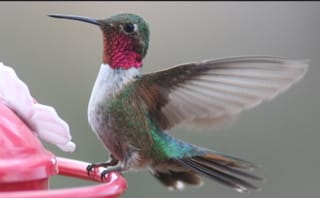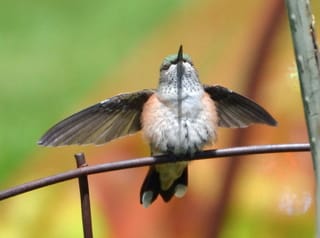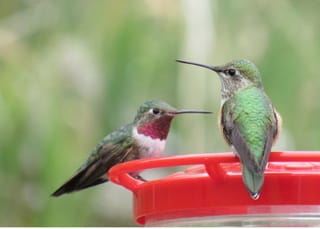Initially this guide displays common birds of all types that are flying right now in our area. Use the selectors below to view rare birds, view birds flying any time, restrict the output to a certain shape of bird, or search by name.
New Mexico is on the western edge of the Central Flyway which is one of the major migration pathways between north and south for birds traveling between breeding and wintering grounds along the Rocky Mountains. This has resulted in the state having an incredible diversity of birds with over 550 different species reported. A little more than half of this number are sighted annually on the Pajarito Plateau. Some of these birds are full-time residents, some migrate here for a few weeks or months, and other are only seen briefly as they pass through the region.
This guide features many of the birds known to frequent Los Alamos county by when they are likely to be seen in the area. You can get additional information on local birds by joining PEEC Birders or going to the eBird website. eBird also includes lists of rare bird sightings and birding hot spots.
Bird References
Birdweb
Cornell Lab of Ornithology
eBird
eNature
Institute for Bird Populations
National Audubon Society
New Mexico Ornithology Society
What Bird
xeno-canto
Subject Area Experts (all guides)
Steve Cary (butterflies)
Beth Cortright (insects)
Terry Foxx (invasive plants)
Leslie Hansen (mammals)
Richard Hansen (fish, mammals)
Dorothy Hoard (butterflies, trees)
Chick Keller (flowers, herbarium)
Shari Kelley (geology)
Kirt Kempter (geology)
Garth Tietjen (reptiles)
David Yeamans (birds)
Web Development and Content Management
Pat Bacha
Jennifer Macke
Graham Mark
Akkana Peck
Contact
Please contact us for local nature questions and sightings. We welcome comments, corrections, and additions to our guides.
For more information about local nature, please visit our Nature Blog or subscribe to PEEC This Week.
Make Selection
 Photo: male by Selvi Viswanathan  Photo: female by Lee Bill  Photo: male and female by Deborah Halter |  Broad-tailed HummingbirdBTAH (Selasphorus platycercus, Trochilus platycercus)Family: Trochilidae (Hummingbirds) Size: 4 - 4.5 in (10 - 11 cm) Flies: Mar 15 - Oct 21 Morphology: both sexes have slender bodies, long tails, iridescent green upper parts, greenish/buffy flanks, white chest, and a line down the belly; males have a magenta gorget; females and immatures have a pale eyering and green spots on their throats and cheeks Status: native; common Food source: mostly nectar and tiny insects; particularly attracted to red flowers Habitat: pinyon-juniper, dry ponderosa pines, mixed fir forests, canyon vegetation Typical location: Los Alamos, White Rock The Broad-tailed Hummingbird has gotten its name from its tendency to spread out its tail feathers, flashing white tail tips. These birds can be seen in large numbers during the summer wherever hummingbird feeders and flowers are present. While they may perch at a feeder, they will usually feed while hovering, extending their long tongues to reach deep into the feeder or flower. They will also catch insects either by flying out to grab them or by plucking them off of foliage. Broad-tailed Hummingbirds will slow their metabolism and go into a state of torpor on cold nights. Nests are located in trees sheltered by an overhanging branch and are made of spider and plant materials covered with moss and bits of bark. Info Photos Distribution Frequency Featured |
